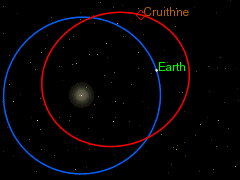준위성
(유사 위성에서 넘어옴)

준위성(準衛星) 또는 유사 위성(類似衛星)은 행성과 1:1로 궤도 공명하며 여러 주기 동안 그 행성에 근접해 있는 천체를 말한다. 행성과 일치하는 주기로 유사한 궤도를 돌지만 보통 궤도 이심률이 더 크다. 실제로는 항성 주위를 공전하는 유사 궤도를 가진 천체일 뿐이지만, 주기 일치로 인해 행성의 관점에서는 장방형의 타원 궤도를 따라 공전하는 것처럼 보인다. 소행성만 발견되고 있으나 이론 상 어떤 유형의 천체라도 유사 위성이 될 수 있다.
실제의 위성과는 다르게 궤도가 행성의 힐 권역 밖에 있어 불안정하다. 근일점 부근에서는 행성을 추월하고 원일점 부근에서는 행성에 뒤쳐지는 식으로 유사 공전 운동이 만들어진다.
행성에 가까이 있을 때는 위성처럼 움직이다 행성에서 멀어지기를 반복한다.
비슷하게 1:1로 궤도공명하는 천체로 트로이 소행성군이 있으나 라그랑주점 L4, L5에서 항성을 공전하여 유사 위성과 달리 항상 멀리 있는 천체로 보인다.
지구의 준위성[편집]

2016년 기준으로 지구에는 (164207) 2004 GU9,[1] (277810) 2006 FV35,[2] 2013 LX28,[3] 2014 OL339[4] (469219) 2016 HO3.[5][6] 다섯 개의 준위성이 알려져 있다.
2016 HO3 등이 현재 지구의 준위성이며 3753 크뤼트네[7], 2002 AA29[8], 2003 YN107, 등은 일시적으로 지구의 준위성이 되는 일이 있는 1:1 궤도 공명 천체이다.
각주[편집]
- ↑ Brasser, R.; 외. (September 2004). “Transient co-orbital asteroids”. 《Icarus》 171 (1): 102–109. Bibcode:2004Icar..171..102B. doi:10.1016/j.icarus.2004.04.019.
- ↑ “Dynamical evolution of Earth’s quasi-satellites: 2004 GU9 and 2006 FV35”. 《Icarus》 209 (2): 488–493. October 2010. Bibcode:2010Icar..209..488W. doi:10.1016/j.icarus.2010.05.012.
- ↑ de la Fuente Marcos, Carlos; de la Fuente Marcos, Raúl (2016). “From horseshoe to quasi-satellite and back again: the curious dynamics of Earth co-orbital asteroid 2015 SO2”. 《Astrophysics and Space Science》 361. arXiv:1511.08360. Bibcode:2016Ap&SS.361...16D. doi:10.1007/s10509-015-2597-8.
- ↑ de la Fuente Marcos, Carlos; de la Fuente Marcos, Raúl. “Asteroid 2014 OL339: yet another Earth quasi-satellite”. 《Monthly Notices of the Royal Astronomical Society》 445: 2985–2994. arXiv:1409.5588. Bibcode:2014MNRAS.445.2961D. doi:10.1093/mnras/stu1978.
- ↑ Agle, DC; Brown, Dwayne; Cantillo, Laurie (2016년 6월 15일). “Small Asteroid Is Earth's Constant Companion”. 《NASA》. 2016년 6월 15일에 확인함.
- ↑ de la Fuente Marcos, Carlos; de la Fuente Marcos, Raúl (2016). “Asteroid (469219) 2016 HO3, the smallest and closest Earth quasi-satellite”. 《Monthly Notices of the Royal Astronomical Society》 462 (4): 3441–3456. arXiv:1608.01518. Bibcode:2016MNRAS.462.3441D. doi:10.1093/mnras/stw1972.
- ↑ Christou, Apostolos A.; Asher, David J. (2011). “A long-lived horseshoe companion to the Earth”. 《Monthly Notices of the Royal Astronomical Society》 414 (4): 2965–2969. arXiv:1104.0036. Bibcode:2011MNRAS.414.2965C. doi:10.1111/j.1365-2966.2011.18595.x.
|journal=에 외부 링크가 있음 (도움말) - ↑ Connors, Martin; Chodas, Paul; Mikkola, Seppo; Wiegert, Paul; Veillet, Christian; Innanen, Kimmo (2002). “Discovery of an asteroid and quasi-satellite in an Earth-like horseshoe orbit”. 《Meteoritics & Planetary Science》 37 (10): 1435–1441. Bibcode:2002M&PS...37.1435C. doi:10.1111/j.1945-5100.2002.tb01039.x.
|journal=에 외부 링크가 있음 (도움말)
| 이 글은 천문학에 관한 토막글입니다. 여러분의 지식으로 알차게 문서를 완성해 갑시다. |

